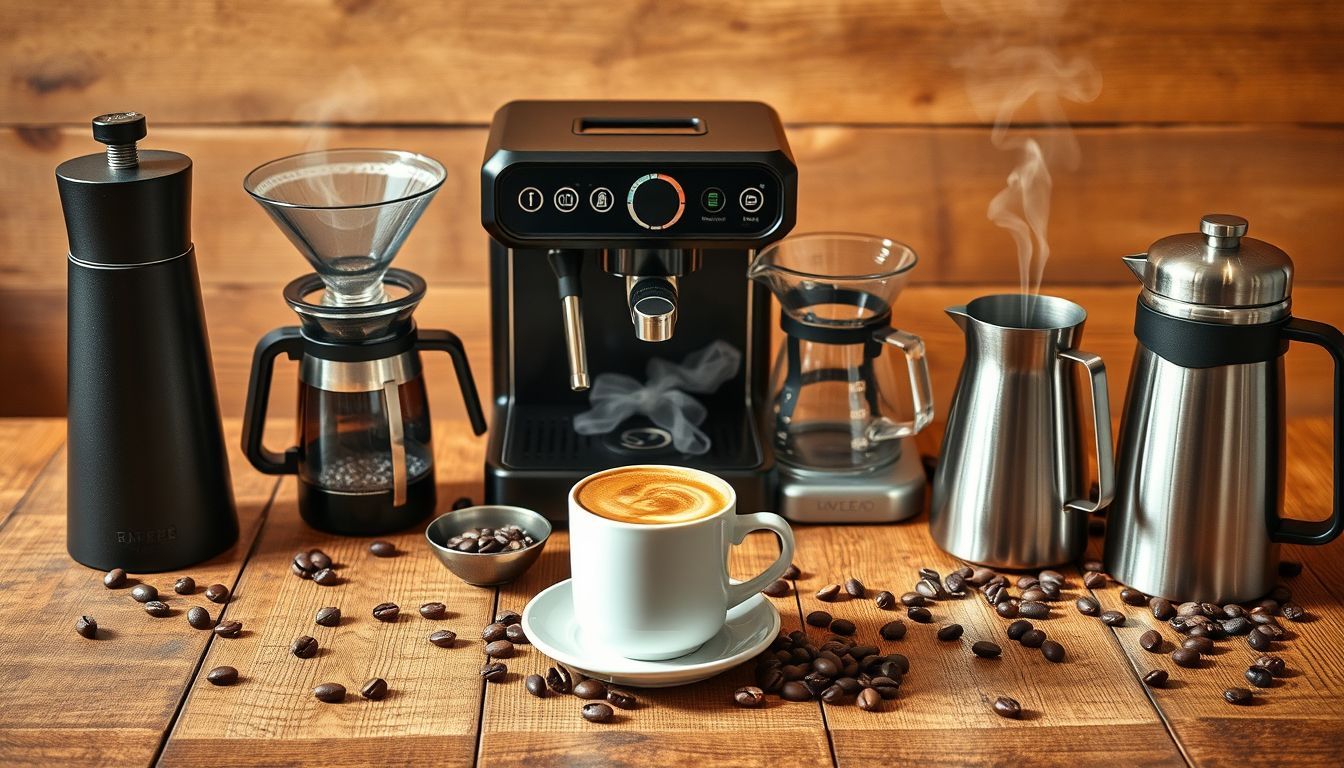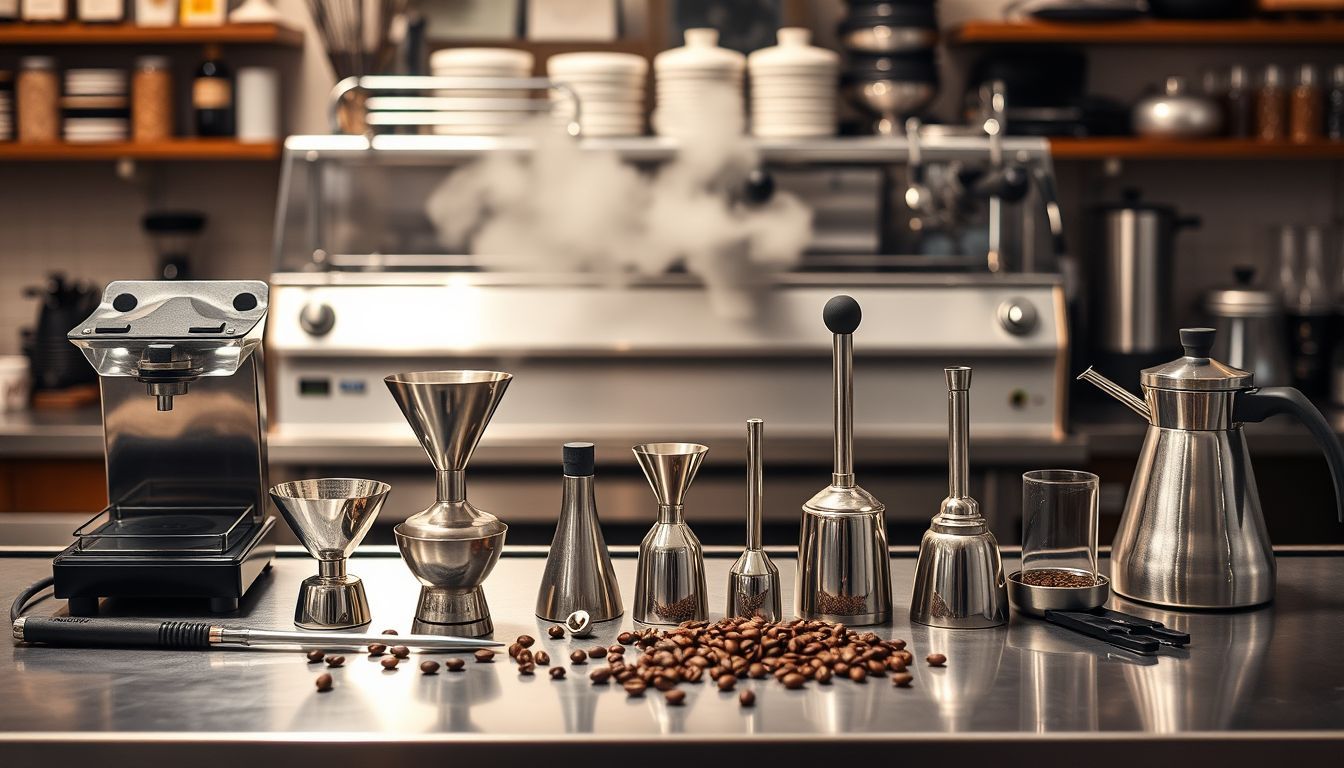The 5 Coffee Tools That Eliminate Common Brewing Mistakes
Discover the precision instruments that transform inconsistent brewing into scientific excellence. These five tools eliminate guesswork and deliver consistently exceptional coffee.

Amazon Affiliate Disclosure
This post contains affiliate links. If you purchase through these links, we may earn a small commission at no additional cost to you.
The 5 Coffee Tools That Eliminate Common Brewing Mistakes
After analyzing thousands of brewing sessions in my laboratory and consulting with cafes worldwide, I've identified a troubling pattern: most coffee disappointments stem from five fundamental brewing mistakes that could be eliminated with the right tools. The difference between mediocre and extraordinary coffee isn't just technique—it's precision.
Today's coffee enthusiasts have access to tools that would make 19th-century coffee pioneers weep with envy. Yet many continue to brew by intuition alone, wondering why their results vary wildly from cup to cup. The solution isn't more expensive beans or exotic brewing methods—it's scientific precision applied through purpose-built instruments.
Let me share the five tools that have revolutionized consistency in my own brewing and those of the professionals I work with.
Tool #1: Digital Scale with 0.1g Precision
The Mistake It Eliminates: Inconsistent Coffee-to-Water Ratios
The most pervasive brewing error I encounter is ratio inconsistency. Coffee scoops are the enemy of precision—a "scoop" can vary by 30% depending on grind size, bean density, and how you fill it. This single variable can transform a balanced cup into either weak dishwater or bitter sludge.
A precision digital scale eliminates this chaos entirely. When I specify a 1:16 ratio (my preferred starting point for most brewing methods), I mean exactly 25.0g of coffee to 400.0g of water—not approximately, not close enough, but exactly.
Recommended Tool: BAGAIL BASICS Coffee Scale with Timer
• 0.1g precision, 3 kg capacity
• Integrated timer
• Backlit LCD display and tare function
Why 0.1g Precision Matters
You might think 0.1g precision is overkill, but consider this: a 0.5g variation in a 25g dose represents a 2% change in strength. In sensory analysis, we can detect strength differences as small as 1.5%. That "barely noticeable" measurement error becomes a clearly perceptible taste difference.
Implementation Strategy
Place your brewing vessel on the scale, zero it out, add your coffee, zero again, then add water. This workflow becomes second nature within a week and eliminates the most common source of brewing inconsistency.
Tool #2: Burr Grinder with Stepless Adjustment
The Mistake It Eliminates: Inconsistent Extraction Due to Poor Grind Quality
Blade grinders are coffee's greatest saboteur. They create a chaotic mixture of powder, properly-sized particles, and large chunks—what we call a "bimodal distribution." The powder over-extracts into bitterness while the chunks under-extract, leaving you with simultaneous bitter and sour notes.
A quality burr grinder with stepless adjustment provides two critical advantages: uniform particle size and precise control over extraction rate.
Recommended Tool: JavaPresse Manual Stainless Steel Coffee Grinder
• Conical ceramic burrs
• 18 precise grind settings
• Portable, hand-crank design
The Science of Uniform Extraction
When particles are uniform, water extracts soluble compounds at a consistent rate across all coffee grounds. This creates what I call "extraction harmony"—all the coffee contributes proportionally to the final cup rather than some particles dominating with negative flavors.
Stepless adjustment allows micro-corrections that stepped grinders cannot achieve. If your coffee is slightly over-extracted, you can make a tiny adjustment rather than jumping to the next step and potentially under-extracting.
Professional Insight
I recommend grinders with flat burrs for filter coffee and conical burrs for espresso, though both can excel in either application with proper adjustment. The key is consistency—once you find your setting for a particular coffee and brewing method, that grinder should return to exactly the same particle size every time.
Tool #3: Temperature-Controlled Gooseneck Kettle
The Mistake It Eliminates: Incorrect Water Temperature and Poor Pour Control
Water temperature directly controls extraction rate, yet most home brewers guess at this critical variable. Too hot (above 205°F), and you'll extract bitter compounds and astringency. Too cool (below 195°F), and you'll under-extract, leaving desirable flavors locked in the grounds.
Pour control is equally crucial but often overlooked. The rate and pattern of water application determines how evenly coffee extracts and how much agitation occurs during brewing.
Recommended Tool: COSORI Electric Gooseneck Kettle with 5 Temperature Control Presets
• 1200W rapid-boil element
• Five preset temperatures (175–212°F)
• Precision gooseneck spout for consistent flow
Temperature Precision in Practice
I brew most light roasts at 203°F and dark roasts at 198°F, but these temperatures must be accurate, not approximate. A temperature-controlled kettle eliminates guesswork and allows you to experiment systematically with different temperatures for different coffees.
The Gooseneck Advantage
The gooseneck spout provides laminar flow control impossible with standard kettles. You can maintain consistent pour rates, create even saturation patterns, and control agitation levels. This transforms pouring from a chaotic variable into a controlled parameter.
Advanced Technique
For pour-over methods, I recommend a spiral pour pattern starting from the center and working outward, maintaining a consistent flow rate of approximately 5 g/second. This technique, enabled by proper kettle design, ensures even extraction across the entire coffee bed.
Tool #4: Digital Timer with Split Functions
The Mistake It Eliminates: Inconsistent Contact Time and Poor Timing Control
Time is extraction's fourth dimension, yet many brewers treat it casually. Contact time—how long water and coffee interact—directly determines extraction yield. Inconsistent timing creates inconsistent results, period.
A dedicated digital timer with split-time functions allows you to track multiple timing elements simultaneously: total brew time, individual pour intervals, and bloom duration.
The Precision of Timing
For pour-over brewing, I target specific timing intervals: 30-second bloom, followed by pours every 30–45 seconds, with total brew time between 4:00–6:00 depending on the method. These aren't arbitrary numbers—they're based on optimal extraction kinetics for different particle sizes and brewing methods.
Tool #5: Refractometer for Extraction Measurement
The Mistake It Eliminates: Brewing Without Feedback on Extraction Quality
This tool represents the leap from intuitive to scientific brewing. A coffee refractometer measures Total Dissolved Solids (TDS), allowing you to calculate extraction yield—the percentage of coffee mass that dissolved into your cup.
Optimal extraction typically falls between 18–22% for most brewing methods. Below 18%, you're under-extracting (sour, weak flavors). Above 22%, you're over-extracting (bitter, harsh notes). The refractometer provides objective feedback on your brewing performance.
Beyond Basic Measurement
With extraction data, you can systematically optimize any brewing recipe. If extraction is low, you can adjust grind size finer, increase temperature, or extend contact time. If extraction is high, you reverse these changes. This transforms brewing from guesswork into systematic optimization.
These five tools create a complete brewing feedback system. The scale ensures consistent ratios, the grinder provides uniform extraction potential, the kettle controls temperature and flow, the timer manages contact time, and the refractometer measures results.
This system allows systematic improvement rather than random experimentation. Change one variable at a time, measure the result, and build a database of optimal parameters for different coffees. Within months, you’ll wonder how you ever brewed coffee without them—and your daily cup will be nothing short of extraordinary.

Marcus Thorne
As a journalist, I learned that the truth is often buried under layers of misinformation and time. As a novelist, I get to do the digging. Whether it's a forgotten event from the Cold War or a present-day conspiracy, I build my stories on a foundation of fact, inviting you to question what you think you know.


